Kyrgyz national games
Traditional Kyrgyz games
Alchiks (Chuko Bones)
Chuko game was the favorite game of little Kyrgyzstani boys in the villages. Alchik or Chuko is a small bone of a knee joint of a ram. Each Kyrgyz child used to have a set of chuko painted in different colors.
The game is similar to the bowling, here the player supposed to use a lot of logic and precision. Alchiks are lined up in a row or circle, and the goal of the players is to throw their alchiks at a distance of several meters to knock out chuko of other players and hit the bones out of the circle. If he succeeds, the player takes the knocked-out chukos for himself so until there are no alchiks left in the game. This game is also sometimes referred to as Ordo, especially if the circle variant is played.

Besh-Tash
Besh-Tash translates as five stones. It is a popular game that usually girls play. Five small, round stones are taken and while four of the pebbles lie on the ground, the player throws up one stone and has time to try to grab another one from the ground until the thrown stone can be caught again from the air. The player must use the same hand for grabbing which she used to throw the rock and also to catch the falling stone. Holding the picked stones on the same hand she repeats the action until no stones are left on the ground or the stone falls uncaught.
Ak-Cholmok
Ak-Cholmok is a traditional Kyrgyz national game that has deep cultural and historical roots. Played primarily by young boys, the game is simple in its setup but requires skill, agility, and teamwork. The name “Ak-Cholmok” can be roughly translated as “White Cloth” or “White Handkerchief,” and the game involves capturing or reaching a specific object, often a cloth or stick, while evading the opposing team.
Cultural Significance of the Ak-Cholmok is more than just a game for physical activity; it plays an important role in Kyrgyz cultural education. The game teaches young participants about agility, coordination, quick decision-making, and the importance of teamwork and cooperation. Traditionally, games like Ak-Cholmok were part of community festivals or celebrations, bringing people together to enjoy collective entertainment, pass on cultural values, and build camaraderie. Moreover, Ak-Cholmok reflects the nomadic lifestyle of the Kyrgyz people, where physical prowess, quick reflexes, and strategic thinking were crucial for survival in the harsh landscapes of Central Asia.
Ak-Cholmok is typically played outdoors, in an open field or a flat area. The participants are divided into two teams. A white cloth or a stick is placed at a certain distance from both teams in the center of the playing field. The goal of the game is for players to capture the cloth (or touch the stick) and bring it back to their team’s side without being tagged by players from the opposing team.
A clear boundary or field is marked, and the “Ak-Cholmok” (the cloth or stick) is placed in the middle. The primary aim for each team is to retrieve the Ak-Cholmok from the center without getting tagged by an opponent. Players take turns or strategically decide who will attempt to grab the Ak-Cholmok, while others from the team act as defenders or distractors. If a player grabs the cloth and is tagged before they return to their side, the other team wins that round. If the player successfully returns with the cloth, their team scores a point. The game encourages teamwork, where players distract opponents, create openings, or cover each other while retrieving the Ak-Cholmok.
While modern entertainment has changed, Ak-Cholmok remains an important traditional game that is still played, particularly in rural areas and during national celebrations or sports festivals. It is one of many traditional Kyrgyz games, like kok-boru (a horseback game similar to polo) or toguz korgool (a traditional board game), that help preserve the cultural heritage of the Kyrgyz people. The significance is that Ak-Cholmok game combines fun, physical activity, and cultural education, continuing to thrive as a symbol of Kyrgyzstan’s rich traditions.
Toguz Korgool
Toguz korgool can be described as a sort of mancala, a board game very popular throughout Asia. The aim of the game is to collect as many pawns as possible. Every player has nine wells and in each of which nine pawns are set in the beginning. Toguz translates as nine in Kyrgyz (and other Turkic languages) which gave the name to the game. This game used to be also played by army officers to develop their military strategy.
Kyrgyz Horse Games
Since time ancient times, the leisure of the Kyrgyz people has been devoted to horse games and entertainment. The nature of many games is completely subordinate to the nomadic way of life and demands great courage, dexterity and readiness for decisive actions.
Kok Boru
Kok-boru horse game is translated as “blue wolf” (Also Kokpar or Buzkashi). In the previous times the wolf attacks on herds of cattle grazing in the mountain valleys were more common than nowadays. When people saw a wolf attacking their herds, the djigits (horse riders) would chase them away on horseback and beat them with a stick when apprehended.
Today’s Kok boru has been formed from practicing for the event of the wolf attacks. The game is played with a real goat or calf carcass which reminds somewhat polo or rugby (in international games a fake goat is sometimes used). The purpose of the game is to grab the goat from the opponent and then pitch in into the opponent side target circle “goal” on the ground.
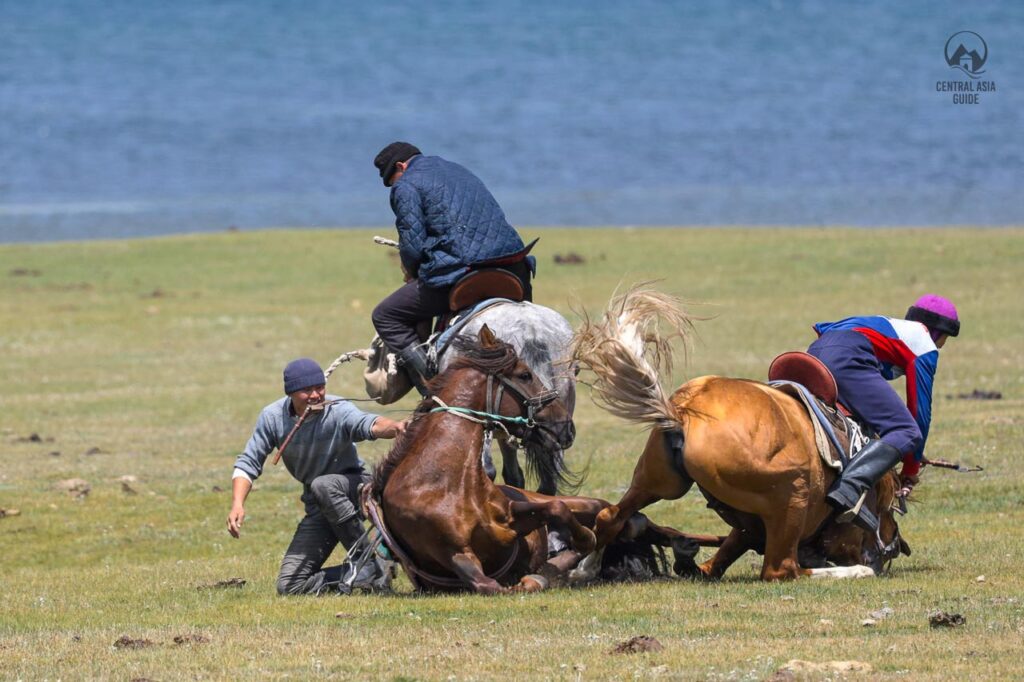
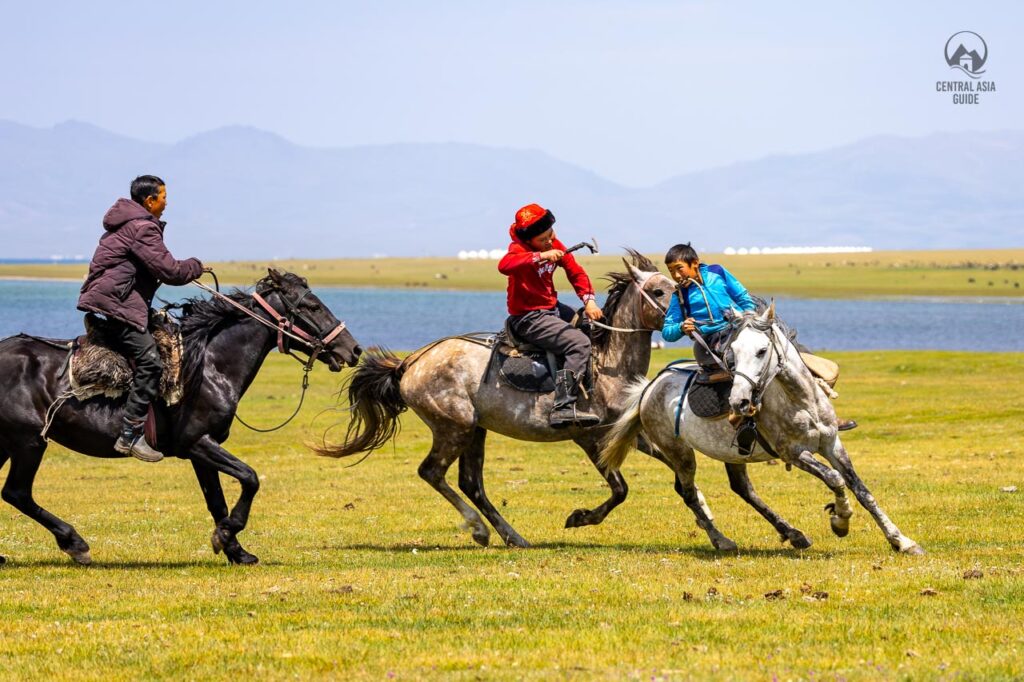
The game looks very rough and players and horses both are sometimes hurt badly. There is a national league played annually in Kyrgyzstan. Most Kok Boru games happen during the colder weather as the horses cannot bear the heat of the game during the hot season. Therefore many of the games during the summertime happen in the higher mountain areas and take place in the lower lands only during the colder periods but as long as March when Nooruz is celebrated. Other Central Asian countries also play the same or a very similar game with some rule differences and they have their own names for it like Buzkashi in Tajikistan, Kokpar in Kazakhstan and Kukpari or Ulak Tartysh in Uzbekistan.
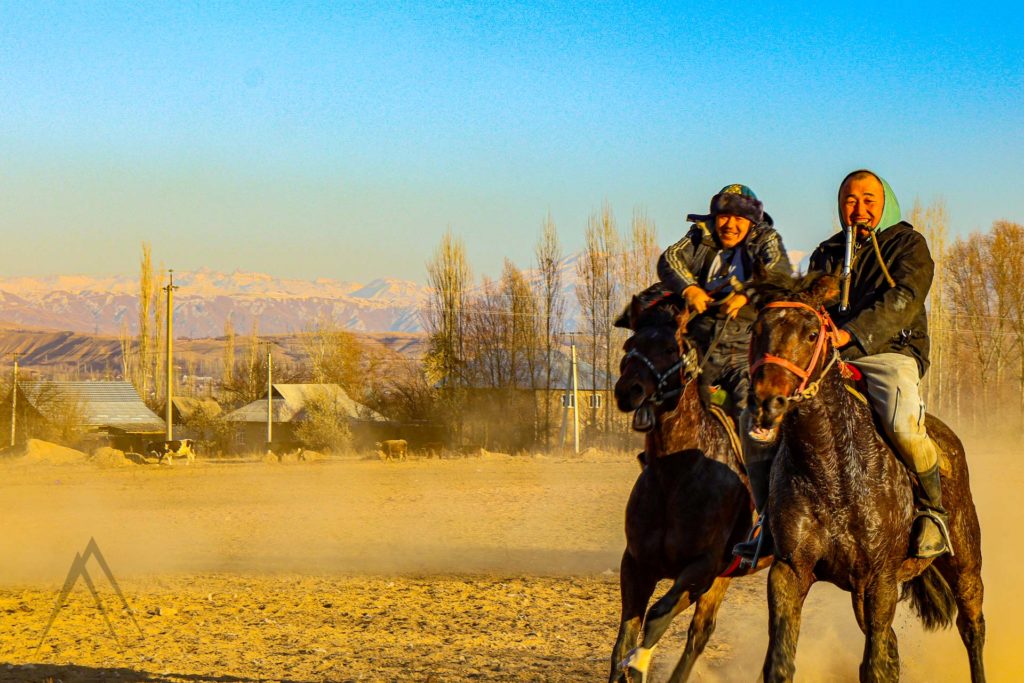
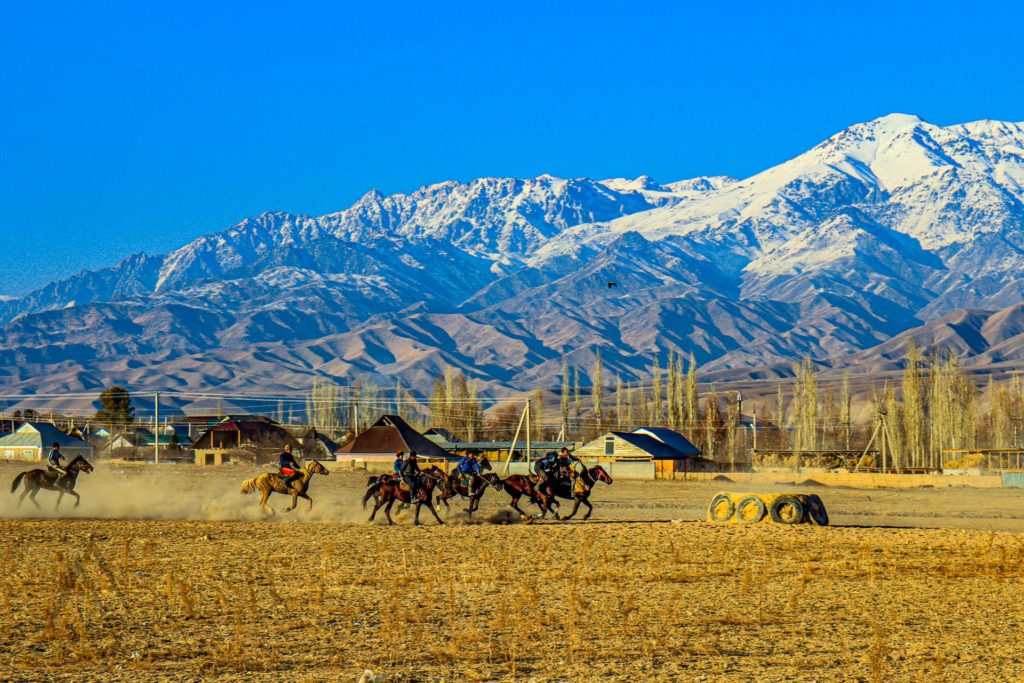
At Chabysh
At chabysh is a horse racing competition for a long-distance. The race involves experienced riders and horses that are at least three year old. The distance of the race is usually 20-30 km and the competitors are mainly male from 13 years and older. The games are mainly organized during the national holidays and festivals.
Kyz-Kuumai
Kyz kuumai “kiss the girl” or “bride chasing” comes from a wedding tradition. The goal for a male rider, usually the groom, is to catch a the young woman (bride) riding horseback and to kiss her. The bride is allowed to use a whip to defend herself from her pursuer.
Alysh (Belt wrestling)
Alysh is an upright wrestling style where competitors wear trousers, jackets and belts and must hold on to their opponents’ belts at all times. The objective of this sport is to throw the opponent onto the mat. Throws are given scores between 1 and 6, based on what part of the opponent lands first on the mat. The first player to achieve 6 points wins the match. Alysh has been recognized by FILA since 2008.
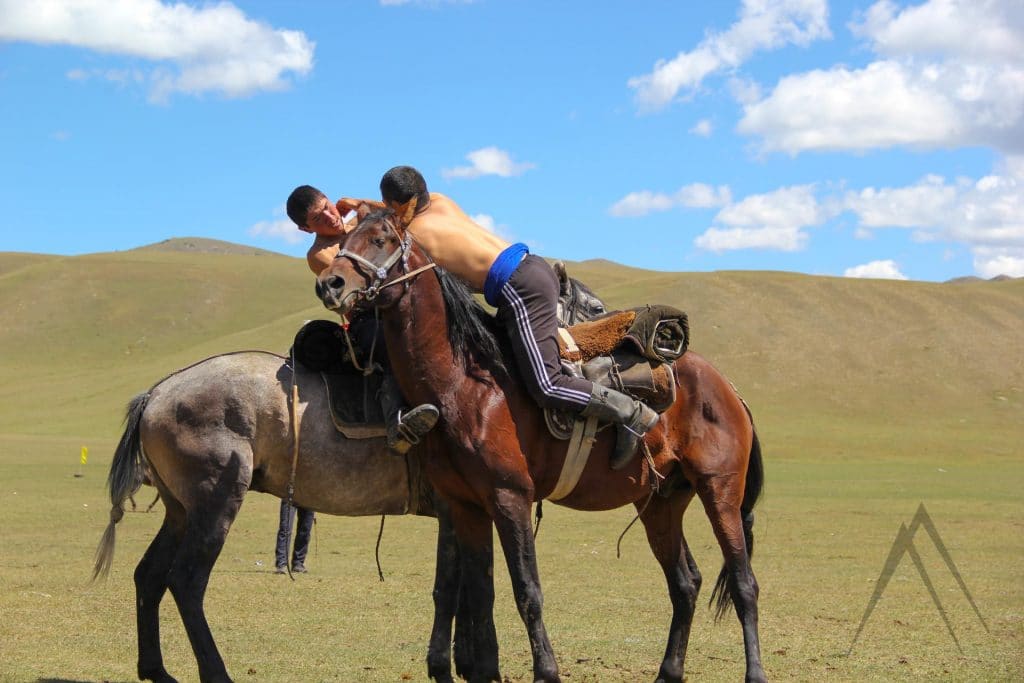
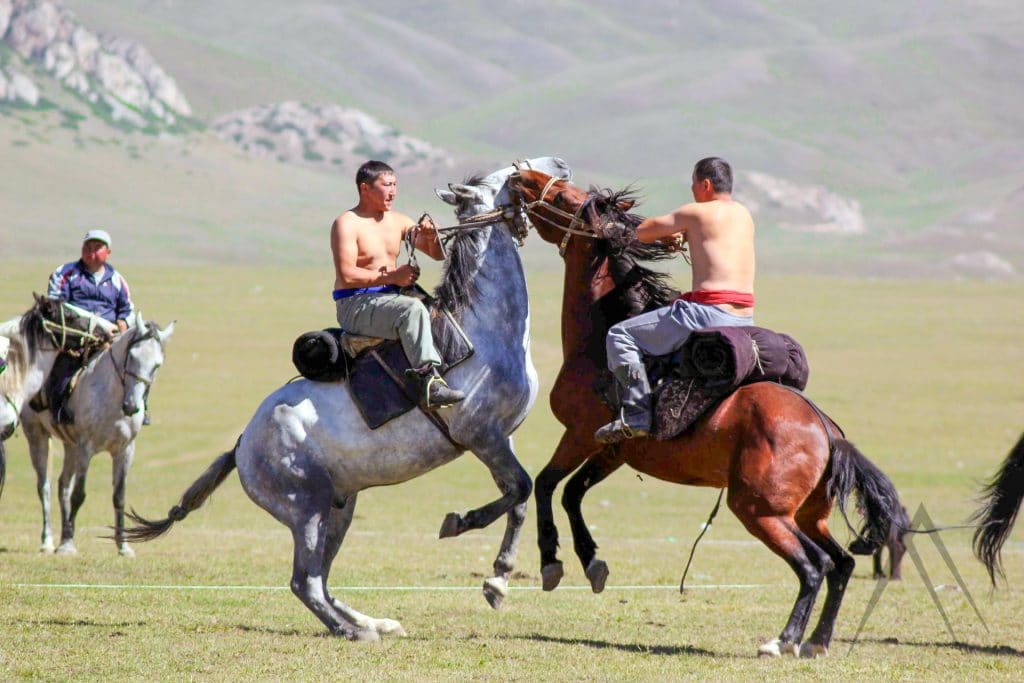
Tiyin Enmei: pick up the money
In this game, young horse riders gallop to pick up money on the ground. These are usually bills of 20 or 50 soms, but it depends on the generosity of the public. The money is usually set in a row and the riders compete who can catch the most. Easy money for the horse masters but almost impossible for anyone else!
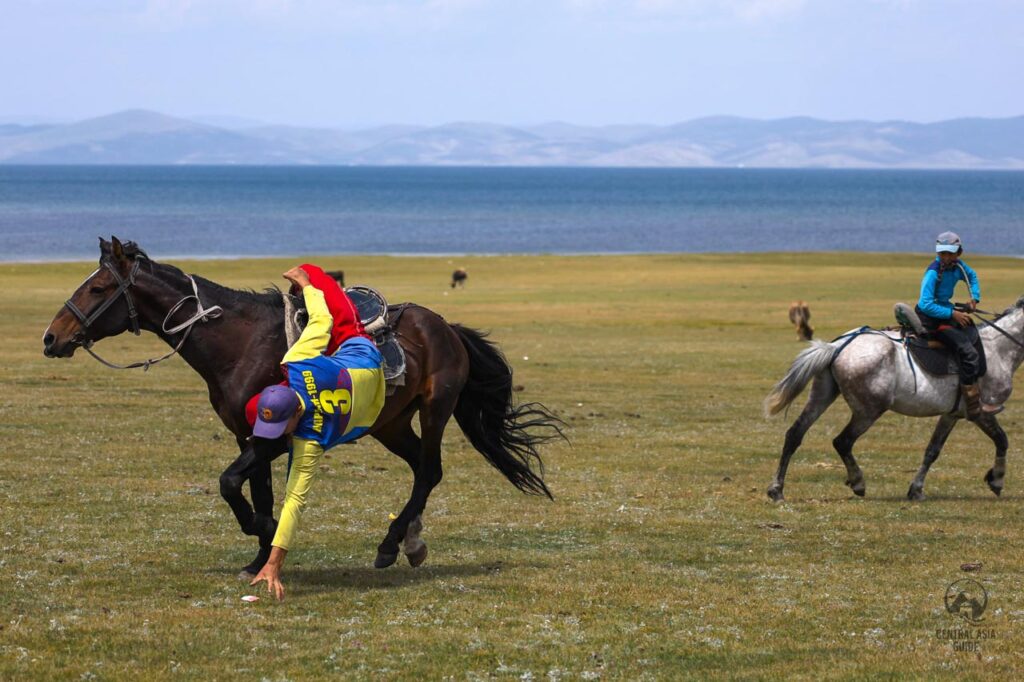
Eagle Hunting in Kyrgyzstan
Cultural traditions such as eagle hunting are going through a renaissance in Kyrgyzstan, although not on the scale known just a few generations ago. In the 21st century Kyrgyz mostly do not train eagles to hunt out of necessity like their ancestors before them but they are instead primarily trained for sporting competitions like the World Nomad Games and for demonstrations provided for tourists.
Best places to see Kyrgyz horsegames & Eagle hunting
Tours including Kyrgyz games
The best way to observe Kyrgyz games in action is during our Kyrgyzstan Tours or Central Asia Tours.
Page updated 8.4.2024